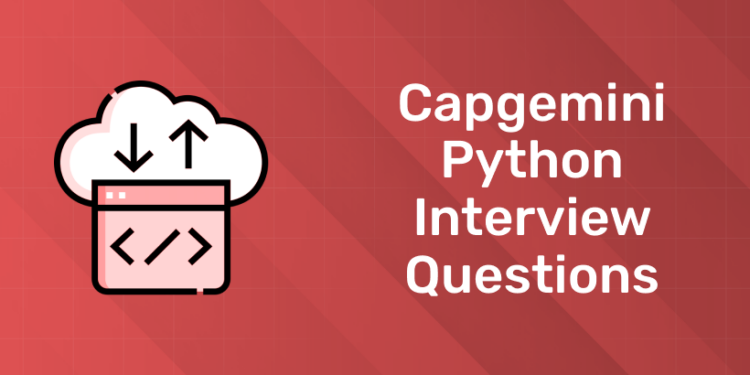Table of Contents
The Python interview questions for Capgemini focus on the candidates’ problem-solving and coding skills. These questions assess proficiency in Python programming language, covering syntax and core concepts. Interviewers often explore candidates’ knowledge of data structures like lists and dictionaries. Understanding Python’s built-in functions and modules is crucial. Technical questions might include coding challenges and algorithm-based problems.
Check out this video on how to learn Python easily by Entri in Malayalam!
This blog lists out the top python interview questions and answers for Capgemini.
Eager to master Python? Enroll in our free demo now!
Capgemini Python Interview
About Capgemini
Capgemini is a global leader in consulting, technology services, and digital transformation. Founded in 1967, it operates in over 50 countries worldwide. The company provides diverse services, including consulting, technology solutions, and outsourcing. Capgemini emphasizes innovation, investing in AI, IoT, and cybersecurity research. They have strategic partnerships with Microsoft, SAP, and Oracle. Additionally, Capgemini focuses on corporate social responsibility and sustainability initiatives.
Global Recognition
- Fortune Global 500: Listed among the largest and most successful companies.
- Forbes Best Employers: Recognized for a positive and inclusive workplace.
Industry Leadership
- IT Services Leader: Recognized by Gartner, Forrester, and IDC for digital transformation.
- Client Success: Award-winning projects in finance, healthcare, and retail.
Innovation
- Research Institute: Acclaimed for AI, IoT, and blockchain research.
- Innovation Awards: Recognized for contributions to emerging technologies.
Sustainability and CSR
- Sustainability Awards: Recognized for reducing carbon footprint.
- CSR Awards: Awarded for diversity, inclusion, and community support.
Workplace Excellence
- Top Employer: Listed by Great Place to Work in various countries.
- Employee Recognition: Commended for a supportive work environment.
Strategic Growth
- Key Acquisitions: Acquired companies like Altran and iGATE.
- Market Expansion: Strengthened presence in North America and other regions.
1. What is a decorator in Python?
def my_decorator(func):
def wrapper():
print(“Something is happening before the function is called.”)
func()
print(“Something is happening after the function is called.”)
return wrapper
@my_decorator
def say_hello():
print(“Hello!”)
2. What is the difference between a list and a tuple?
Ans. The primary difference between a list and a tuple is that lists are mutable, meaning they can be changed after their creation, whereas tuples are immutable and cannot be changed once created.
3. Explain the concatenation property in tuples.
Ans. Although tuples are immutable, you can concatenate two tuples using the + operator to create a new tuple.
4. When should you prefer tuples over lists?
Ans. Tuples should be used when the data is fixed and does not need to be changed, whereas lists should be used when the data is likely to be modified.
5. Which is better, Django or Flask?
Ans. Both frameworks have their own advantages. Django is a high-level, monolithic framework that requires a thorough understanding of its components, making it suitable for larger projects. Flask is a micro-framework that is lightweight and better for smaller applications or scripts. My personal preference is Django due to my extensive experience with it.
6. Which libraries do you use in Python?
Ans. I use several libraries, including requests, os, json, numpy, and pandas.
7. How do you combine two data frames in pandas?
Ans. You can combine two data frames using the append or concat methods. Here’s an example:
df1 = pd.DataFrame({‘A’: [1, 2], ‘B’: [3, 4]})
df2 = pd.DataFrame({‘A’: [5, 6], ‘B’: [7, 8]})
combined = pd.concat([df1, df2])
8. How do you read files in Python?
Ans. You can read files using the with open keyword:
with open(‘file.txt’, ‘r’) as file:
data = file.read()
Using with open ensures the file is properly closed after reading.
9. What is the purpose of the with keyword in file handling?
Ans.The with keyword ensures that resources are properly managed and automatically closed after their usage, which eliminates the need to manually close the file.
10. How do you check if a string is a palindrome?
Ans. You can check if a string is a palindrome using slicing:
def is_palindrome(s):
return s == s[::-1]
11. What are the most commonly used Git commands?
Ans. Some commonly used Git commands are:
- git init: Initializes a new Git repository.
- git pull: Pulls updates from a remote repository.
- git checkout: Switches branches.
- git add: Stages changes.
- git commit: Commits staged changes.
- git push: Pushes commits to a remote repository.
12. Which databases have you worked with?
Ans. I am more comfortable with RDBMS like MySQL and PostgreSQL.
Named After Monty Python: Python wasn’t named after a snake but after the British comedy group Monty Python. The creator, Guido van Rossum, wanted a name that was short, unique, and slightly mysterious. Hence, Python!
13. How do you set up PostgreSQL in Python?
Ans. You can set up PostgreSQL using the psycopg2 library:
import psycopg2
conn = psycopg2.connect(“dbname=test user=postgres password=secret”)
14. How do you configure PostgreSQL in Django?
Ans. You configure PostgreSQL in Django by updating the DATABASES setting in settings.py:
DATABASES = {
‘default’: {
‘ENGINE’: ‘django.db.backends.postgresql’,
‘NAME’: ‘your_db_name’,
‘USER’: ‘your_db_user’,
‘PASSWORD’: ‘your_db_password’,
‘HOST’: ‘your_db_host’,
‘PORT’: ‘your_db_port’,
}
}
15. Do you have experience with Docker, Jenkins, or AWS?
Ans. I have basic knowledge and understanding of Docker, Jenkins, and AWS, and have used these tools for various tasks in my projects.
16. What are Python’s key features?
Ans. Python’s key features include:
- Simple and easy to learn: Python’s syntax is clear and intuitive.
- Interpreted language: Python code is executed line by line, making debugging easier.
- Object-oriented: Python supports object-oriented programming, promoting code reuse.
- High-level language: Python abstracts low-level details, allowing developers to focus on problem-solving.
- Extensive libraries: Python has a rich set of libraries and frameworks for various tasks, including web development, data analysis, machine learning, and more.
17. What is the difference between deepcopy and copy in Python?
Ans.
- copy.copy() creates a shallow copy of an object. It copies the object itself, but not the objects it refers to.
- copy.deepcopy() creates a deep copy of an object. It copies the object as well as all the objects it refers to, recursively.
18. How does Python manage memory?
Ans. Python manages memory using a private heap space. The Python memory manager handles the allocation of heap space for Python objects. The built-in garbage collector is used to recycle unused memory to make it available for heap space.
19. What is a lambda function in Python?
Ans. A lambda function is a small anonymous function defined with the lambda keyword. It can have any number of arguments but only one expression. The expression is evaluated and returned. Syntax:
lambda arguments: expression
add = lambda x, y: x + y
print(add(2, 3)) # Output: 5
20. How do you handle exceptions in Python?
Ans. Exceptions in Python are handled using the try, except, else, and finally blocks. Example:
try:
# Code that may raise an exception
result = 10 / 0
except ZeroDivisionError:
# Code to handle the exception
print(“Cannot divide by zero.”)
else:
# Code to execute if no exceptions occur
print(“Division successful.”)
finally:
# Code to execute regardless of whether an exception occurs
print(“Execution complete.”)
21. What are Python iterators and generators?
Ans.
- Iterators: An iterator is an object that contains a countable number of values and can be iterated upon, meaning it returns one value at a time.
- Generators: Generators are a simple way of creating iterators using a function and the yield statement. Each call to yield produces a value and suspends the function’s state, which is resumed when the next value is requested.
22. How do you create a virtual environment in Python?
Ans. A virtual environment in Python can be created using the venv module:
python -m venv myenv
To activate the virtual environment:
- Windows: myenv\Scripts\activate
- Mac/Linux: source myenv/bin/activate
23. What is list comprehension in Python?
Ans. List comprehension provides a concise way to create lists. It consists of brackets containing an expression followed by a for clause. Example:
squares = [x**2 for x in range(10)] print(squares) # Output: [0, 1, 4, 9, 16, 25, 36, 49, 64, 81]
24. Explain the difference between ‘==’ and ‘is’ operators.
Ans.
- == checks for value equality. It compares the values of both operands.
- is checks for reference equality. It compares the memory locations of both operands.
a = [1, 2, 3]
b = a
c = a[:]
print(a == b) # Output: True
print(a is b) # Output: True
print(a == c) # Output: True
print(a is c) # Output: False
25. How do you create a dictionary in Python?
Ans. A dictionary in Python can be created using curly braces { } with key-value pairs, or by using the dict() function:
# Using curly braces
my_dict = {‘name’: ‘John’, ‘age’: 30}
# Using dict() function
my_dict = dict(name=’John’, age=30)
Eager to master Python? Enroll in our free demo now!
🚀 Start Coding Today! Enroll Now with Easy EMI Options. 💳✨
Gain expertise in Django and open doors to lucrative opportunities in web development.
Start Learning With EMI Payment OptionsCapgemini Python Interview: Conclusion
Capgemini python interview consists of 4 rounds. The technical, analytical and behavioral aspects of the candidate is thoroughly checked during the process. Candidate can use this article to understand the process and also practice for their interview with sample questions given here.
If you want to start learning Python or brush up on language, Entri’s Python programming course is the suitable one. With industry experts as mentors and top-notch materials, you can easily dominate the interview as well as your career. So enrol now and kickstart your career to success.
🚀 Start Coding Today! Enroll Now with Easy EMI Options. 💳✨
Gain expertise in Django and open doors to lucrative opportunities in web development.
Start Learning With EMI Payment OptionsFrequently Asked Questions
What types of Python questions are commonly asked in Capgemini technical interviews?
- Basics of Python (data types, loops, functions)
- Object-oriented programming
- Libraries like NumPy or Pandas
- Practical coding problems to solve
How should I prepare for a Python coding test at Capgemini?
- Practice coding problems on sites like LeetCode or HackerRank
- Review algorithms and data structures
- Write clean and efficient code
- Practice debugging and testing your code
What is the importance of Python libraries in Capgemini's interview process?
- Shows you can use tools to solve problems
- Know popular libraries like NumPy, Pandas, and Matplotlib
- Understand how to apply these libraries in real projects
Can you give an example of a practical Python problem that might be asked in a Capgemini interview?
- Example problem: “Find the longest substring without repeating characters in a string”
- Tests problem-solving, string manipulation, and efficient coding skills
What should I expect during the technical interview round for a Python developer position at Capgemini?
- Mix of theory questions and coding challenges
- Explain your thought process and previous projects
- Solve coding problems on the spot
- Write and explain your code, answer follow-up questions















